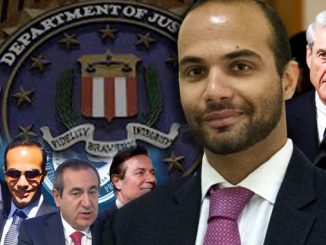
The Bureau’s admission that it had operative(s) inside campaign absolves the president and potentially two of his high-profile allies, as well, Roger Stone and Michael Caputo.
By S.T. Patrick
According to a recent court filing, the 2016 Trump campaign was infiltrated by the FBI through more than one “confidential human source,” a general classification that includes informants and spies. The FBI infiltration chiefly targeted former foreign policy advisor Carter Page as the point of entry to the campaign staff.
When the Department of Justice (DOJ) released heavily redacted copies of the four Foreign Intelligence Surveillance Act (FISA) warrants against Page, David Heath of USA Today sued using the Freedom of Information Act (FOIA).
David M. Hardy, the head of the FBI’s Records/Information Dissemination Service (RIDS) responded to the lawsuit.
Hardy acknowledged that the redactions were used to protect the identities of their own confidential sources as well as the sources obtained by former MI6 operative Christopher Steele. It was the UK’s Steele who assembled what is known as the “Steele Dossier,” an intelligence report comprised of memos Steele had written between June and December 2016. The still unproven dossier alleged that the Trump campaign had colluded with the Kremlin to disrupt the campaign of Hillary Clinton in the 2016 U.S. presidential election.
Fusion GPS, a Washington, D.C. political research firm, hired Steele, the former head of the Russia desk for MI6 in London between 2006 and 2009. Fusion GPS had a shared attorney, Marc Elliot, with the Clinton campaign, which had paid Fusion GPS to investigate links between Trump and Russia. CNN has since reported that the Clinton campaign and the DNC directly financed and then produced what was then known as the Trump dossier. Steele had remained the unnamed source of the dossier until The Wall Street Journal published his identity in January 2017.
Steele was not alone in his gathering of intelligence within the Trump campaign. He had met with several Department of Justice FBI officials, including Bruce and Nellie Ohr.
Bruce Ohr is a high-ranking official at the Department of Justice who has spent his career battling organized crime and has investigated Russian organized crime activities within the U.S.
Ohr’s wife, Nellie, was hired by Fusion GPS as a Russia specialist and cybersecurity expert to conduct “research and analysis” of Trump. Fluent in Russian, she once worked for Open Source Works, which analyzes intelligence for the CIA. In recent testimony before the House Judiciary and Oversight Committees, Mrs. Ohr invoked “spousal privilege” when asked about conversations with her husband, Fusion GPS, and the dossier.
ABC News has concluded that the Ohrs remain insignificant to the story of the dossier. Democratic lawmakers continue to downplay any possible collusion between the FBI, the DOJ, and the CIA to negatively affect Trump’s administration by aiding Robert Mueller’s special investigation.
“This is just a big nothing-burger to me,” said Rep. Raja Krishnamoorthi (D-Ill.). “It’s been a big waste of time. I haven’t heard anything or seen anything that leads me to believe there’s some conspiracy at DOJ or FBI or anything untoward happened.”
 There has, however, been evidence that the Pentagon and the FBI used intelligence assets to approach foreign policy advisors within Trump’s 2016 campaign.
There has, however, been evidence that the Pentagon and the FBI used intelligence assets to approach foreign policy advisors within Trump’s 2016 campaign.
The Pentagon enlisted University of Cambridge professor Stefan Halper, a U.S. citizen and experienced political analyst and intelligence asset, to approach and befriend three members of the 2016 Trump campaign. Halper was paid over $1 million in Department of Defense contracts throughout the Obama years, over 60% of which came after Trump announced his candidacy. Halper had approached both Page and George Papadopoulos, a former member of the foreign advisory panel to the Trump campaign.
The FBI revelations may, in part, absolve Roger Stone and Michael Caputo, two high-profile Trump allies. In late May 2016, Caputo arranged for Stone to meet with a Russian national identifying himself as “Henry Greenberg.” Greenberg asked for $2 million in exchange for information about Clinton. Stone looked at the man in the “Make America Great Again” hat and said, “You don’t understand Donald Trump. . . . He doesn’t pay for anything.” Stone then texted “waste of time” to Caputo. Following the reports of Halper’s infiltration of the campaign, Stone stated that he believed the meeting was an “FBI sting operation.”
Halper also targeted campaign national co-chair Sam Clovis. In August 2016, Halper reached out to Clovis, asking him to meet somewhere near Washington, D.C. According to Clovis’s attorney, “[Halper] said he wanted to be helpful to the campaign” and lend to Clovis his foreign policy expertise. Halper asked Clovis about China but reports from Clovis are that the subject of Russia was never discussed.
The FOIA lawsuit and FBI response seem to validate Trump’s May 18 tweet: “Reports are that there was at least one FBI representative implanted, for political purposes, into my campaign for president. It took place very early on, and long before the phony Russia hoax became a ‘hot’ fake news story.”
S.T. Patrick holds degrees in both journalism and social studies education. He spent 10 years as an educator and now hosts the “Midnight Writer News Show.” His email is [email protected].




